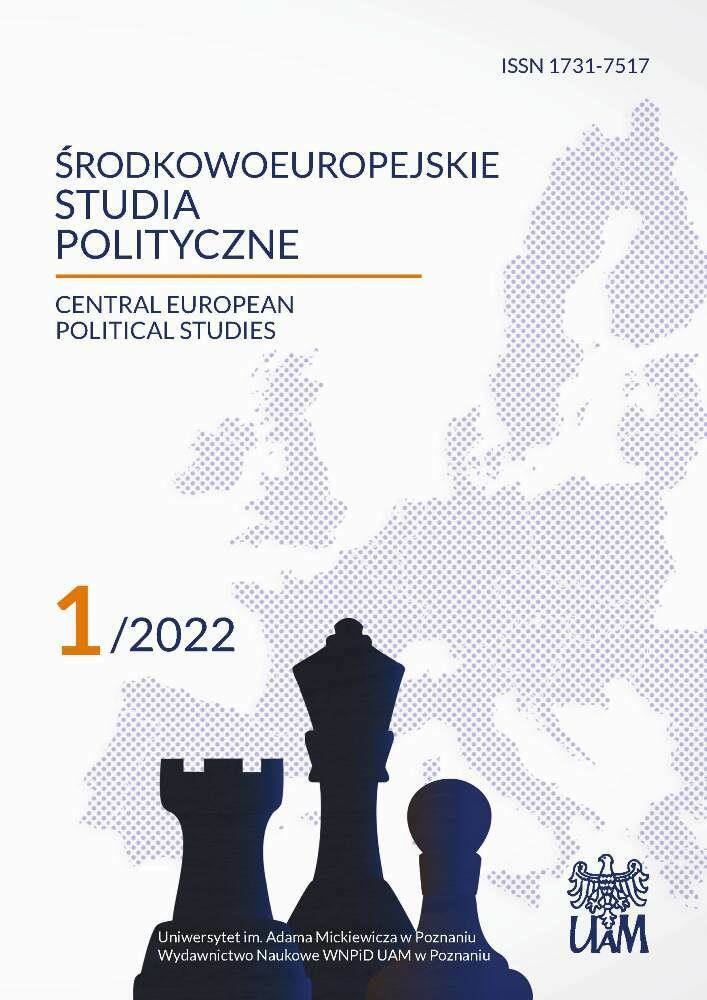Abstract
The political development of Romania started after the death of Nicole Ceausescu in 1989. The article describes and analyses institutional and behavioural dynamics of the political processes that have occurred in Romania since 1989. This article focuses on the constitutional framework of governing institutions. This paper tries to explore the understanding of theoretical approaches to political and institutional development in the country. It examines the evolution of legislative, executive, and judiciary bodies. These are the three pillars of democracy. The article discusses how political parties participating in elections, form a government and will look at the stability of the institutions. This article examines institutional foundations of the coalition government in the 1990–2020 post-communist democracy period in Romania. The article starts with the institutional framework premise that electoral systems and constitutional provisions on the division of powers, structure, and the relationship between parliament and the president determines the point at which political power can be dispersed or concentrated in the political system.
References
Agh A. (1998), Emerging Democracies in East-Central Europe and the Balkans, Books.
Alexandru I. (2016), Again, about Justice Independence and Its Relationships with the Parliament and Government, “Review. Universul Juridic”, p. 5.
Aniţei A. C. (2014), Post Mortem Assisted Reproductive Technology (Art) And the Particular Case of The Will in Romania, “Contemporary Legal Institutions” 6, no. 1.
Bharti S. S. (2020), Strengthening the Development Partnership between the EU and South Asia: A Contemporary Analysis, “Slovak Journal of Political Sciences”, 20(2), pp. 278–298, DOI: https://doi.org/10.34135/sjps.200205.
Bureau T. (2015), Migrant Political Participation and Voting Behaviour in Romania, Paper to be presented at APSA San Francisco 3–6 September.
Carey H. F. (1989), Romania since 1989: Politics, Economics, and Society, Lexington books.
Chamber of Deputies (2018), How Parliament of Romania Works, http://www.cdep.ro/pls/dic/site.page?id=108, 04 January 2022.
Chamber of Deputies (n.d.), Constitution of Romania 1991, http://www.cdep.ro/pls/dic/site.page?den=act1_2.
Chiva C. (2007), The institutionalisation of post-Communist parliaments: Hungary and Romania in comparative perspective, “Parliamentary Affairs” 60(2), pp. 187–211.
Constitutional Court of Romania (2011), National report on Separation of Powers and Independence of Constitutional Courts and Equivalent Bodies, https://www.venice.coe.int/WCCJ/Rio/Papers/ROM_Toader_E.pdf.
Constitution of Romania (2003), Constitution of Romania, http://www.cdep.ro/pls/dic/site.page?den=act2_2&par1=3, 04 January 2022.
ECPR (2016), Migrant Political Culture and Voting Behaviour in Romania, Toma Bureau and Gabriel Badescu Political Science Department Faculty of Political Science Public Administration and Communication Babes-Bolyai University, Cluj-Napoca, Romania, https://ecpr.eu/Filestore/PaperProposal/007bc7d4-dc45-4e1d-a333-dd1933a709fc.pdf, 04 January 2022.
European Election Database (1996), Romania: Parliamentary Election, http://www.nsd.uib.no/europeanelection database/country/Romania/parliamentaryelections.html, 02 June, 2022.
European Election Database (2004), Romania: Parliamentary Election 204), http://eed.nsd.uib.no/webview/index.jsp?study=http%3A%2F%2F129.177.90.166%3A80%2Fobj%2FfStudy%2FROPA2004_Display&mode=cube&v=2&cube=ttp%3A%2F%2F129.177.90.166%3A80%2Fobj%2FfCube%2FROPA2004_Display_C1&top=yes.
European Union (2007), Romania Overview, https://european-union.europa.eu/principles-countries-history/country-profiles/romania_en.
Fish M. S. (2006), Stronger legislatures, stronger democracies, “Journal of democracy” 17(1), pp. 5–20.
Foundation Robert Schuman (2014), Presidential election in Romania, 2nd November 2014, https://www.robert-schuman.eu/en/doc/oee/oee-1544-en.pdf.
Ganev V. I. (2013), Post-accession hooliganism: Democratic governance in Bulgaria and Romania after 2007, “East European Politics and Societies” 27(01), pp. 26–44.
Gonenc L. (ed.) (2002), Prospects for constitutionalism in post-communist countries, vol. 50, Martinus Nijhoff Publishers.
Huntington S. P. (1993), The third wave: Democratization in the late twentieth century, vol. 4, University of Oklahoma Press.
Ilie C. (ed.) (2010), European parliaments under scrutiny: Discourse strategies and interaction practices, vol. 38, John Benjamins Publishing.
Krastev I., Holmes S. (2019), How liberalism became ‘the god that failed’, https://www.theguardian.com/world/2019/oct/24/western-liberalism-failed-post-communist-eastern-europe, 07 March 2022.
Lord C., Erika H. (2017), Democracy in the new Europe, Bloomsbury Publishing.
Negrut V. (2017), Considerations on the Legal Regime Applicable to the Romanian Government Ordinances, “EIRP Proceedings” no. 12.
Nicolae M. J. (2010), Regional Analyses of Voting Behaviour in Romania–Local, General and Presidential Elections, “Romanian Journal of Regional Science” 4(2), pp. 62–77.
The permanent electoral authority (2022), Report on the Organization and Deployment for Election of Chamber of Deputies and Senate from November 30, 2008, p. 121–122, http://www.roaep.ro/, 04 January 2022.
Pirvulescu C. (2001), Local public administration in Romania, “Local Self Government and Decentralization in South-East Europe” 1000(2000), p. 225.
Robert Shuman (2009), Presidential Election in Romania 22nd November and 6th December 2009, https://www.robert-schuman.eu/en/eem/0956-presidential-election-in-romania-22nd-november-and-6th-december-2009.
Roper S. D. (1989), Parliamentary development, “Romania since”, pp. 159–177.
Romanian Constitution (2003), Romania’s Constitution of 1991 with Amendments through 2003, https://www.constituteproject.org/constitution/Romania_2003.pdf?lang=en.
Safta M. (2020), Aspects regarding the competence of the President of Romania in the Government’s investiture and the Ministers’ appointment, “Conferința Internaționala de Drept, Studii Europene și Relații Internaționale” 8 (VIII), pp. 103–112.
Saramet O. (2015), Executive Powers in Relations with the Parliament: Part I, “Agora Int’l J. Jurid. Sci”, p. 68.
Smilov D., Krastev I. (2008), The Rise of Populism in Eastern Europe: Policy Paper, in: Populist Politics and Liberal Democracy in Central and Eastern Europe, eds. G. Mesežnikov, O. Gyárfášová, S. Daniel, Bratislava.
Stanescu L. S. (2013), The Structure of The Romanian Parliament from The Perspective of Its Optimizing and Of the Cooperation Mechanism with The European Parliament, “The USV Annals of Economics and Public Administration” 12, no. 1 (15), pp. 244–255.
Sussex European Institute (2009), Romanian Presidential Elections, pp. 9–10, http://www.sussex.ac.uk/sei/1-4-2.html.
Tanase T. (2014), The electoral campaign through Social Media. Case Study 2014 Presidential elections in Romania, http://www.sferapoliticii.ro/sfera/183/pdf/183.09.Tanase.pdf, 04 January 2022.
Tanase T. (2015), The electoral campaign through Social Media. Case Study–2014 Presidential elections in Romania, “Sfera politician” 23(183/1), pp. 92–104.
The Constitutional Court of Romania (2003), The constitution of Romania Revised, https://www.ccr.ro/constitutia-romaniei-2003, 04 January 2022.
Vida I. C. (2014), Role and Attributions of The President of Romania In the Romanian State System, “Applied Social Sciences: Administration and Management”, p. 171.
Vilcu D. A. (2014), Romanian diaspora: The 2014 presidential elections as positive community practice, “Jurnalul Practicilor Comunitare Pozitive”, 14(4), pp. 113–127.
License
Copyright (c) 2022 Mukesh Shankar BHARTI

This work is licensed under a Creative Commons Attribution 4.0 International License.

